|
|
Vectors in a Plane and Space |
|
|
|
Vectors
in a Plane |
 Subtraction of vectors
Subtraction of vectors |
 Scalar multiplication
or multiplication of a vector by scalar
Scalar multiplication
or multiplication of a vector by scalar |
|
Unit vector |
 Addition, subtraction
and scalar multiplication of vectors, examples
Addition, subtraction
and scalar multiplication of vectors, examples |
|
|
|
|
|
|
| Subtraction of vectors |
| Subtraction of two vectors,
|
 |
is defined as addition of vectors
|
 |
that is,
|
|
|
 |
| As shows
the right figure, subtraction of two vectors can be
|
| accomplished directly.
|
| By using translation place tails of both vectors at the same
|
|
point and connect their
tips. |
| Note
that the arrow (tip) of the difference
coincides with the tip of |
| the first
vector ( minuend). |
|
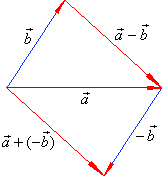 |
|
|
| Scalar multiplication
or multiplication of a vector by scalar
|
| Scalar is a quantity which is fully expressed by its magnitude or size
like length, time, mass, etc. as any real number.
|
| By multiplying a vector
a
by a real number
l
obtained is the vector l
a
collinear to
a
but,
|
| l times longer
then a
if | l
| > 1,
or shorter then a
if
| l
| < 1,
and |
|
directed as a
if l
> 0,
or opposite to a
if l
< 0,
|
|
as is shown in the below figure.
|
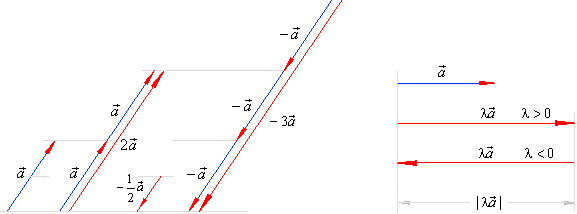 |
|
| Thus, the magnitude of the vector
l
a
equals to the product of the absolute value of the real number
l
and |
|
the magnitude of the vector
a, that is |
 |
|
| Besides, for the multiplication of a vector by a real number
following rules hold:
|
| 1)
l
· ( a + b ) = l
a + l
b |
| 2)
( l
+ m
) · a = l
a + m
a,
l,
m
Î R |
| 3)
l
( m
a ) = m
( l
a ) = ( m
l
) a |
| 4)
1 · a = a,
-1
· a = -
a |
| 5)
0 · a = 0,
m
· 0 = 0 |
|
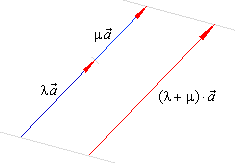 |
|
|
| In the similar triangles
ABC and
ADE
in the
right |
| figure,
AE
: AC
= DE
: BC
= AD
: AB
= l |
| therefore,
AE
= l
· AC. |
| Since
AE
= l
a + l
b
and AC
= a + b |
| then,
l
a + l
b = l
· ( a + b ). |
|
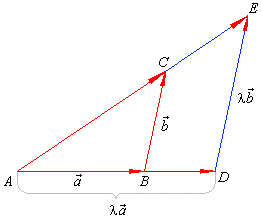 |
|
|
| Unit vector |
| A vector
|
 |
is called the
unit vector of a vector
|
 |
if
|
 |
|
| Therefore,
|
 |
|
| the unit vector
|
 |
determines the direction of the vector
|
 |
|
|
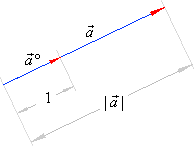 |
|
|
| Addition, subtraction
and scalar multiplication of vectors, examples |
| Example: |
Given are vectors,
|
 |
determine
|
 |
|
|
|
|
|
| Example:
Given is a regular hexagon
ABCDEF with the center
O. Express vectors
CD,
BE,
EA,
and
|
| CE,
in terms of vectors, AB
= a
and BC
= b.
|
| Solution:
|
|
|
 |
 |
|
| Example: Determine the distance of the midpoint
M, of the segment
P1P2, and the point
O, if points,
P1
and P2
are heads of vectors p1
and p2 respectively, and whose tails coincide
with the point O
as shows the figure. |
| Solution: The
vector P1P2
represents the difference p2
-
p1. |
|
 |
|
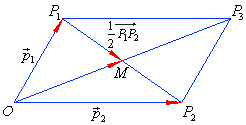 |
|
|
| Example: In a triangle
ABC drown are medians as vectors,
|
 |
|
| Prove
that
|
 |
|
| Solution:
Replacing the sides of the triangle by vectors, directed as in
the diagram,
|
 |
|
|
|
|
| Example:
Use vectors to prove that line segments joining the midpoints of adjacent sides of a quadrangle,
|
| form a parallelogram.
|
| Solution: The sides of the quadrangle ABCD are replaced by vectors, directed as in
the diagram so that the |
| opposite vectors connecting midpoints are, |
|
|
| As equal vectors are of same lengths and parallel, therefore the line segments connecting the midpoints of any quadrangle, form a parallelogram. |
|
| Example:
Determine a vector which coincides with the angle bisectors of vectors, a
and b
in the diagram.
|
| Solution: The unit vectors of the given vectors
are, |
 |
| and they form a rhombus whose diagonal is |
 |
|
| That is, a vector |
 |
will coincide
with |
|
| the angle bisector, while a vector |
 |
|
|
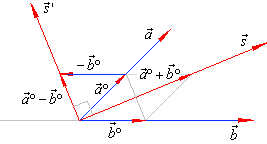 |
|
| defines
the angle bisector of the supplementary angle of vectors, a
and b.
|
|
|
|
|